Mar 21, 2014
US Senator Kerry’s climate nostrums will make the patient worse
James Rust
On February 16, Secretary of State John Kerry gave a long speech in Jakarta, Indonesia on climate change policy and ripped into those who disagreed with his thinking saying, “We simply don’t have time to let a few loud interest groups hijack the climate conversation… We should not allow a tiny minority of shoddy scientists and science and extreme ideologues to compete with scientific facts… The science is unequivocal, and those who refuse to believe it are simply burying their heads in the sand...” Actually Mr. Kerry it’s scientific illiterates and idealogues like you that have their head buried in the sand

Kerry back home in Massachusetts
Secretary Kerry also said scientists claim climate changes are leading to drought, wildfires, rising sea levels, melting polar ice, plant and animal extinctions, and other extreme conditions. The solution, Kerry said, is a new global energy policy that shifts reliance from fossil fuels to cleaner technologies. He noted President Barack Obama is championing such a shift and encouraged others to appeal to their leaders to join.
Tens of millions of Americans take offense to an American Secretary of State on foreign soil labeling them “a tiny minority of shoddy scientists and science and extreme ideologues to compete with scientific facts.” There is no precedent for such actions.
Historical data covering almost one million years show no significant role of carbon dioxide changes on temperatures. The scares about global warming (climate change) are due to a multitude of computer models that predict present and future global temperatures and events like sea level rise. All models overestimate current and future global temperatures. Secretary Kerry read off a list of climate catastrophes that have centuries of data showing their occurrences when carbon dioxide levels were not increasing. Surprisingly, during the recent period of increasing carbon dioxide many of these events are less frequent and powerful.
The preceding paragraph covers a lot of climate science that show most of Secretary Kerry’s statements are false. Evidence is found on the Internet from a group of scientists, the Nongovernmental International Panel on Climate Change, and their most recent report Climate Change Reconsidered II: Physical Science. Another report by Popular Technology lists 1350 + peer-reviewed papers challenging global warming by categories such as Arctic, sea level rise, temperatures, etc.
Secretary Kerry’s remarks are political and attempting to convince American’s the nation should adopt policies to reduce fossil fuel use and lead the world in a United Nations (UN) Climate Change Conference in Paris 2015. Statements by UN individuals associated with the climate treaty give insight on future policies. Christiana Figueres, executive secretary of the UN Framework Convention on Climate Change, said in a 2014 interview at Bloomberg News, “China is also able to implement policies because its political system avoids some of the legislative hurdles seen in countries including the US… Key policies, reforms and appointments are decided at plenums, or meeting of the governing Communist Party’s more than 200-strong Central Committee. The National People’s Congress, China’s unicameral legislature, largely enforces decisions made by the party and other executive organs.”
Ottmar Edenhofer, co-chair of the IPCC Working Group III, gave the following interview with Neue Zurcher Zeitung November 14, 2010 : “De facto, this means an expropriation of the countries with natural resources. This leads to a very different development from that which has been triggered by development policy.”
Edenhofer replied, “First of all, developed countries have basically expropriated the atmosphere of the world community. But one must say clearly that we redistribute de facto the world’s wealth by climate policy. Obviously, the owners of coal and oil will not be enthusiastic about this. One has to free oneself from the illusion that international climate policy is environmental policy. This has almost nothing to do with environmental policy anymore, with problems such as deforestation or the ozone hole.”
These individuals, as well as Secretary Kerry and President Obama, want a new world order where the United States cedes sovereignty to demands of the United Nations.

Enlarged
Fossil fuel use is the lifeblood of developed industrial nations. It has eliminated hunger, poverty, lack of shelter, drudgery, and provided healthier, more comfortable, and longer lifespans. The United States is blessed by having over one hundred years or more supply of inexpensive or moderate cost deposits of each of the fossil fuels - coal, oil, and natural gas. Secretary Kerry, along with President Obama and his supporters, want to eliminate use of the nation’s abundant, reliable, and economical fossil fuels and replace them with renewable energy sources - wind and solar - whose present state of technology make them expensive, unreliable, and impractical to scale up to the size of present fossil fuel capabilities. These policies will substantially lower the standard of living for Americans and condemn developing nations to perpetual poverty.
Secretary Kerry’s solutions to the non-existent global warming problem can be compared to the pre-20th century medical practice of bloodletting - patients not cured and many die.
All of Secretary Kerry’s and President Obama’s plans to relieve “Climate Change{ are a total waste of money. Society has used common sense to mitigate natural climate change for many thousands of years. Umbrellas were invented to make traveling more comfortable during rainfall. Secretary Kerry’s plans are similar to using government to tell the public to open umbrellas during rainfall. With the U. S. government sinking in debt $2 billion per day, do we need to waste tax dollars on agencies to tell us to do what we would naturally do?
Damage to the nation’s economy by climate and energy policies of Secretary Kerry and President Obama require examination. The public needs to thoroughly study these issues and make decisive votes in the 2014 and 2016 elections.
------------
Environmentalists giving away Earth Day condoms to supporters to combat overpopulation - earth average IQ to rise
In honor of Earth Day this year, groups are giving out 44,000 “Endangered Species Condoms.”
The environmentally friendly condoms will be distributed in an effort to refocus the green holiday back to why it was started: to campaign against “runaway human population growth and overconsumption.”
“April 22 is the 44th Earth Day, and this year we want to bring the holiday’s focus back to its origins: runaway human population growth and overconsumption, the root causes of our most pressing environmental crises,” the Center for Biological Diversity wrote in a pitch to its supporters.
“We need people across the country to help distribute 44,000 Endangered Species Condoms in time for Earth Day,” the Center continued. “These colorful, fun condom packages feature six species threatened by our growing human population already more than 7 billion along with talking points to help get the conversation started.”
Environmentalists have been increasingly turning back to arguments that the world is on its way to having too many people to sustain life. Californians for Population Stabilization attempted to make overpopulation the central theme of Earth Day 2013, saying that rapid population growth imperils biodiversity and causes habitat loss.
“The consequences of that growth are all around us - loss of open space, air and water pollution, traffic congestion, and never-ending sprawl,” said Jo Wideman, executive director of Californians for Population Stabilization. “Habitat loss due to population growth is the greatest threat to wildlife.”
Even Al Gore has said that “fertility management” was the key to sustainable development in the third world - an important component of the fight against global warming.
David Brower, a former executive director of the Sierra Club who also sat on the groups board as recently as 2000, once said, “Overpopulation is perhaps the biggest problem facing us, and immigration… has to be addressed.”
The emphasis on “fertility management” and population control comes as more and more evidence casts doubt upon the validity of the theory of man-made global warming. Global temperatures have been flat for the last 17 years or so and so-called “extreme weather” events have not been on the rise, despite environmentalist rhetoric.
The public has also become more skeptical that global warming will be catastrophic. A recent Gallup poll found that 42 percent of Americans say the seriousness of global warming is “generally exaggerated” by the media, compared to 33 percent who say its “generally underestimated.”
And while 57 percent of Americans believe that global warming is caused by humans, that’s fewer than the 61 percent that believed so in 2007. This is on top of the fact that no major global warming bill has been able to pass Congress since the failed attempt to pass cap-and-trade in 2009 and 2010.
Today the world’s populations is at about 7 billion, nearly double what it was in 1970 when the first Earth Day was celebrated. According to the United Nations, the world’s population will reach about 10 billion by 2050.
Around the time of the first Earth Day, scientists Paul Ehrlich and John Holdren, now the White House science czar, worried that the world’s population would outstrip technology and food production capabilities. Ehrlich and Brower wrote the book “The Population Bomb,” which warned of mass starvation in the 1970s and 1980s due to overpopulation. The book advocated for population control to remedy the future threat.
The book’s dire predictions failed to materialize. The world’s population continued to grow and new technologies enabled farmers to realize huge increases in food production. And as poor countries like China and India began to develop, they too began to bring people out of poverty and chronic hunger.
The United Nations Food and Agriculture Organization estimates that one-eighth of the world’s population suffered from chronic undernourishment in 2010-2012. The number of hungry people in the world declined by 132 million between 1990-92 and 2010-12 - from 18.6 percent to 12.5 percent of the world’s population.
Feb 27, 2014
Statement of Patrick Moore, Ph.D. Before the Senate Environment and Public Works Committee
Patrick Moore
UPDATE: John Coleman of KUSI: How the Global Warming Scare Began
A great scientist named Roger Revelle had Al Gore in his class at Harvard and the Global Warming campaign was born. Revelle tried to calm things down years later, but Gore said Revelle was senile and refused to debate. John Coleman documents the entire story and shows how our tax dollars are perpetuating the Global Warming alarmist campaign even though temperatures have not risen in years and years.
-------------
Also read Dr. Larry Bell’s More Scientists Debunking Climate Change Myths
-------------
By Patrick Moore
It is a powerful convergence of interests among a very large number of elites, including politicians who want to make it seem as though they’re saving the world, environmentalists who want to raise money and get control over very large issues like our entire energy policy, media, for sensationalism, Universities and professors for grants. You can’t hardly get a science grant these days without saying it has something to do with climate change.
It is a kind of nasty combination of extreme political ideology and a religious cult all rolled into one, and it’s taken over way too much of our thought process and way too much of our priorities. There are millions of children dying every day from preventable vitamin deficiencies and diseases, and we are spending hundreds of billions of dollars on a problem that may not exist.
Senate Testimony February 25, 2014
“Natural Resource Adaptation: Protecting ecosystems and economies”
Chairman Whitehouse, Ranking Member Inhofe, and members of the Committee. Thank you for the opportunity to testify at today’s hearing.
In 1971, as a PhD student in ecology I joined an activist group in a church basement in Vancouver Canada and sailed on a small boat across the Pacific to protest US Hydrogen bomb testing in Alaska. We became Greenpeace.
After 15 years in the top committee I had to leave as Greenpeace took a sharp turn to the political left, and began to adopt policies that I could not accept from my scientific perspective. Climate change was not an issue when I abandoned Greenpeace, but it certainly is now.
There is no scientific proof that human emissions of carbon dioxide (CO2) are the dominant cause of the minor warming of the Earth’s atmosphere over the past 100 years. If there were such a proof it would be written down for all to see. No actual proof, as it is understood in science, exists.
The Intergovernmental Panel on Climate Change (IPCC) states: “It is extremely likely that human influence has been the dominant cause of the observed warming since the mid-20th century.” (My emphasis)
“Extremely likely” is not a scientific term but rather a judgment, as in a court of law. The IPCC defines “extremely likely” as a “95-100% probability”. But upon further examination it is clear that these numbers are not the result of any mathematical calculation or statistical analysis. They have been “invented” as a construct within the IPCC report to express “expert judgment”, as determined by the IPCC contributors.
These judgments are based, almost entirely, on the results of sophisticated computer models designed to predict the future of global climate. As noted by many observers, including Dr. Freeman Dyson of the Princeton Institute for Advanced Studies, a computer model is not a crystal ball. We may think it sophisticated, but we cannot predict the future with a computer model any more than we can make predictions with crystal balls, throwing bones, or by appealing to the Gods.
Perhaps the simplest way to expose the fallacy of “extreme certainty” is to look at the historical record. With the historical record, we do have some degree of certainty compared to predictions of the future. When modern life evolved over 500 million years ago, CO2 was more than 10 times higher than today, yet life flourished at this time. Then an Ice Age occurred 450 million years ago when CO2 was 10 times higher than today. There is some correlation, but little evidence, to support a direct causal relationship between CO2 and global temperature through the millennia. The fact that we had both higher temperatures and an ice age at a time when CO2 emissions were 10 times higher than they are today fundamentally contradicts the certainty that human-caused CO2 emissions are the main cause of global warming.
Today we remain locked in what is essentially still the Pleistocene Ice Age, with an average global temperature of 14.5C. This compares with a low of about 12C during the periods of maximum glaciation in this Ice Age to an average of 22C during the Greenhouse Ages, which occurred over longer time periods prior to the most recent Ice Age. During the Greenhouse Ages, there was no ice on either pole and all the land was tropical and sub-tropical, from pole to pole. As recently as 5 million years ago the Canadian Arctic islands were completely forested. Today, we live in an unusually cold period in the history of life on earth and there is no reason to believe that a warmer climate would be anything but beneficial for humans and the majority of other species. There is ample reason to believe that a sharp cooling of the climate would bring disastrous results for human civilization.
Moving closer to the present day, it is instructive to study the record of average global temperature during the past 130 years. The IPCC states that humans are the dominant cause of warming “since the mid-20th century”, which is 1950. From 1910 to 1940 there was an increase in global average temperature of 0.5C over that 30-year period. Then there was a 30-year “pause” until 1970. This was followed by an increase of 0.57C during the 30-year period from 1970 to 2000. Since then there has been no increase, perhaps a slight decrease, in average global temperature. This in itself tends to negate the validity of the computer models, as CO2 emissions have continued to accelerate during this time.
The increase in temperature between 1910 to 1940 was virtually identical to the increase between 1970-2000. Yet the IPCC does not attribute the increase from 1910 to 1940 to “human influence.” They are clear in their belief that human emissions impact only the increase “since the mid-20th century”. Why does the IPCC believe that a virtually identical increase in temperature after 1950 is caused mainly by “human influence”, when it has no explanation for the nearly identical increase from 1910 to 1940?
It is important to recognize, in the face of dire predictions about a 2C rise in global average temperature, that humans are a tropical species. We evolved at the equator in a climate where freezing weather did not exist. The only reasons we can survive these cold climates are fire, clothing, and housing. It could be said that frost and ice are the enemies of life, except for those relatively few species that have evolved to adapt to freezing temperatures during this Pleistocene Ice Age. It is “extremely likely” that a warmer temperature than today’s would be far better than a cooler one.
I realize that my comments are contrary to much of the speculation about our climate that is bandied about today. However, I am confident that history will bear me out, both in terms of the futility of relying on computer models to predict the future, and the fact that warmer temperatures are better than colder temperatures for most species.
If we wish to preserve natural biodiversity, wildlife, and human well being, we should simultaneously plan for both warming and cooling, recognizing that cooling would be the most damaging of the two trends. We do not know whether the present pause in temperature will remain for some time, or whether it will go up or down at some time in the near future. What we do know with “extreme certainty” is that the climate is always changing, between pauses, and that we are not capable, with our limited knowledge, of predicting which way it will go next.
Thank you for the opportunity to present my views on this important subject.
Attached please find the chapter on climate change from my book, “Confessions of a Greenpeace Dropout: The Making of a Sensible Environmentalist”. I would request it be made part of the record.
Feb 25, 2014
Cruz to CNN: Global warming not supported by data
CNN Chief Congressional Correspondent Dana Bash and CNN Senior Congressional Producer Deirdre Walsh
Beaumont, TX (CNN) - Sen. Ted Cruz, R, Texas, questions whether global warming is real, arguing that the “data are not supporting what the advocates are arguing.”

“The last 15 years, there has been no recorded warming. Contrary to all the theories that - that they are expounding, there should have been warming over the last 15 years. It hasn’t happened,” said Cruz.
Cruz spoke to CNN in an exclusive interview following an event here to promote his new energy plan, which he says he will formally introduce in the Senate next week.
When pressed about the fact that the arctic is melting, and whether that helps prove climate change is real, Cruz dismissed it.
“Other parts are going up. It is not - you know, you always have to be worried about something that is considered a so-called scientific theory that fits every scenario. Climate change, as they have defined it, can never be disproved, because whether it gets hotter or whether it gets colder, whatever happens, they’ll say, well, it’s changing, so it proves our theory,” argued Cruz.
“I am always troubled by a theory that fits every perfect situation. You know, back in the ‘70s - I remember the ‘70s, we were told there was global cooling. And everyone was told global cooling was a really big problem. And then that faded. And then we were told by Al Gore and others there was global warming and that was going to be a big problem. And then it morphed. It wasn’t global warming anymore, it became climate change. And the problem with climate change is there’s never been a day in the history of the world in which the climate is not changing,” said Cruz.
Secretary of State John Kerry recently made waves by declaring climate change is “perhaps - perhaps the world’s most fearsome weapon of mass destruction.”
Not surprisingly, Cruz disagreed.
“Well, you know, it is ironic that Secretary Kerry would say that, uh, given that he is, right now, in the process of negotiating with the nation of Iran in - in what Israel’s prime minister, Benjamin Netanyahu, has called an historically bad deal,” said Cruz.
“It is ironic that he sees a greater threat from your SUV in your driveway than he does from the nation of Iran, with their radical Islamic jihad and and their stated desire to obliterate, to annihilate Israel. He sees a greater threat from your SUV than he does to Iranian nuclear weapons,” Cruz said of Kerry.
Cruz chose the Spindle Top Boomtown Museum here, where oil discovery sparked the Texas oil boom more than a century ago, to push his ideas to support what he calls a “great American energy renaissance.”
His proposal includes many traditional GOP ideas more oil drilling and expanding energy exploration and repealing many EPA regulations he calls harmful.
Missing from his official plan are other forms of energy, what Republicans call “all of the above,” but he told CNN he does support alternative energy, as long as it comes from the private sector, not the federal government.
“We ought to be allowing the private sector to pursue every form of energy because the energy of the future, it’s not going to come from the government picking winners and losers,” Cruz told CNN.
“We ought to open up energy innovation across the board and - and remove the barriers to every form of energy.”
Feb 23, 2014
Time to push back against the global warming Nazis
Dr. Roy Spencer
ICECAP NOTE: Roy is not the only one pushing back against the powerful, heavily funded warmist political machine. Read how Mark Steyn and others are battling Michael Mann in this excellent summary by Judith Curry.
In it, Dr Curry, chair of the School of Earth and Atmospheric Sciences at the Georgia Institute of Technology, acknowledges something really quite extraordinary:
With regards to climate science, IMO the key issue regarding academic freedom is this: no scientist should have to fall on their sword to follow the science where they see it leading or to challenge the consensus. I’ve fallen on my dagger (not the full sword), in that my challenge to the consensus has precluded any further professional recognition and a career as a university administrator. That said, I have tenure, and am senior enough to be able retire if things genuinely were to get awful for me. I am very very worried about younger scientists, and I hear from a number of them that have these concerns.
Tenure is an amazing privilege for academics. And now we see in the Mann/UVa case, that the establishment academics are worried about fear of embarrassment by public disclosure and fear that those who dislike their findings will conduct invasive fishing expeditions in search of a pretext to discredit them. Come on, big boy pants please. We are talking about publicly funded research, and a primary concern is supposed to be avoiding embarrassing the scientists?
:
For the past decade, scientists have come to the defense of Michael Mann, somehow thinking that defending Michael Mann is fighting against the ‘war on science’ and is standing up for academic freedom. It’s time to let Michael Mann sink or swim on his own. Michael Mann is having all these problems because he chooses to try to muzzle people that are critical of Mann’s science, critical of Mann’s professional and personal behavior, and critical of Mann’s behavior as revealed in the climategate emails. All this has nothing to do with defending climate science or academic freedom.
The climate science field, and the broader community of academics, have received an enormous black eye as a result of defending the hockey stick and his behavior.
------
Time to Push Back against the Global Warming Nazis
By DR. Roy Spencer
Yeah, somebody pushed my button.
When politicians and scientists started calling people like me “deniers”, they crossed the line. They are still doing it.
They indirectly equate (1) the skeptics’ view that global warming is not necessarily all manmade nor a serious problem, with (2) the denial that the Nazi’s extermination of millions of Jews ever happened.
Too many of us for too long have ignored the repulsive, extremist nature of the comparison. It’s time to push back.
I’m now going to start calling these people “global warming Nazis”.
The pseudo-scientific ramblings by their leaders have falsely warned of mass starvation, ecological collapse, agricultural collapse, overpopulation...all so that the masses would support their radical policies. Policies that would not voluntarily be supported by a majority of freedom-loving people.
They are just as guilty as the person who cries “fire!” in a crowded theater when no fire exists. Except they threaten the lives of millions of people in the process.
Like the Nazis, they advocate the supreme authority of the state (fascism), which in turn supports their scientific research to support their cause (in the 1930s, it was superiority of the white race).
Dissenting scientific views are now jack-booted through tactics like pressuring scientific journals to not publish papers with which they disagree...even getting journal editors to resign.
Like the Nazis, they are anti-capitalist. They are willing to sacrifice millions of lives of poor people at the altar of radical environmentalism, advocating expensive energy policies that increase poverty. And if there is a historically demonstrable threat to humanity, it is poverty.
I’m not talking about those who think we should be working toward new forms of energy to eventually displace our dependence of fossil fuels. Even I believe in that; after all, fossil fuels are a finite resource.
I’m instead talking about the extremists. They are the ones who are sure they are right, and who are bent on forcing their views upon everyone else. Unfortunately, the extremists are usually the only ones you hear from in the media, because they scream the loudest and make the most outrageous claims.
They invoke “consensus”, which results from only like-minded scientists who band together to support a common cause.
This authoritarianism tends to happen with an over-educated elite class...I have read that Nazi Germany had more PhDs per capita than any other country. I’m not against education, but it seems like some of the stupidest people are also the most educated.
So, as long as they continue to call people like me “deniers”, I will call them “global warming Nazis”.
I didn’t start this fight...they did. Yeah, somebody pushed my button.
NOTE: A couple people in comments have questioned my use of “Nazi”, which might be considered over the top. Considering the fact that these people are supporting policies that will kill far more people than the Nazis ever did - all in the name of what they consider to be a righteous cause, I think it is very appropriate. Again, I didn’t start the name-calling.
Other terms like Marxists also apply.
-------
Blue - the movie you MUST see so you truly realize the danger from the green environmental movement
There is a movie available called “Blue” that will show the green movement’s true color - red (or as Delingpole has written watermelon - green oustide - red inside).
“BLUE will change the radical green direction we’ve been heading.”
That’s what Curtis Bowers, director of the award-winning documentary Agenda: Grinding America Down, said about J.D. King’s new video documentary BLUE.
Our good friend Curtis is right!
Documentary film maker J.D. King has done a masterful job. Circling the globe, he presents the testimony of some of the world’s leading scholars on environmental science, economics, ethics, and politics to lay bare many of the common falsehoods of the Green movement.
He shows how they harm people - especially the poor.
And he offers a truly Christian perspective on earth stewardship in its place.
The result is a film that combines beauty and passion to convey sound science and economics, excellent Christian worldview and theology, and keen political insight in an entertaining way.
BLUE will captivate viewers old and young alike.
What does BLUE stand for?
B stands for Beautify. It’s our job to make this planet more beautiful. This task requires the use of our heads and our hands. This is the crucial point where BLUE differs from Green: BLUE believes active management is the best way to enhance the earth, while Green believes in preservationism. Preservationism means adopting a hands-off, “let nature do its thing” approach to environmental matters. Active management, on the other hand, means seeking out ways to make nature better.
L is for Liberate. Today, we enjoy some of the longest and healthiest lives on the most fruitful planet in history. Why? Because humanity, especially in the West, has become more free than ever before. BLUE believes people can create solutions to problems, if only granted freedom and private property rights. This means less government. Green uses government to restrict human activity and freedom. But BLUE promotes limited government, where people are free to make decisions for themselves and their property.
U is for Utilize. BLUE is for wisely utilizing natural resources. But wait, isn’t mining, drilling, and logging bad for the planet? Well, they can be, just like eating too much is unhealthy. But the careful extraction of natural resources is actually good for nature. Using resources also creates jobs. In turn, we can invest the added wealth into studying ecology and cleaning up our planet. In nearly every case, the more free and wealthy a country is, the healthier is its environment.
E is for Enjoy. Green loves alarmism, and to tell you to worry about everything from polar bears and ice caps to CO2 emissions and the weather. BLUE, while acknowledging facts, challenges the hysteria and believes in the God-given power of human creativity and freedom to solve our problems. History is a story of humanity finding solutions to difficulties. The only necessary ingredient is freedom. So let freedom ring and don’t forget to simply enjoy this beautiful BLUE planet we call home.
The Cornwall Alliance played an important part in the making of BLUE. We provided extensive consultation from inception to completion, as well as featured interviews with Founder and National Spokesman Dr. E. Calvin Beisner and Senior Fellows Dr. Vishal Mangalwadi and Dr. Steven F. Hayward.
Among the other outstanding scholars and leaders J.D. presents in BLUE are nuclear physicist and cultural analyst Dr. Robert Zubrin, author of Merchants of Despair: Radical Environmentalists, Criminal PseudoScientists, and the Fatal Cult of Antihumanism; Lord Christopher Monckton, science advisor to former British Prime Minister Margaret Thatcher and among the world’s leading critics of global warming alarmism; Geologist Dr. Leighton Steward, Chairman of the Board of the Institute for the Study of Earth and Man at Southern Methodist University and Chairman of the non-profit organization Plants Need CO2, who explains the benefits of increased atmospheric carbon dioxide to earth’s ecosystems and humanity through increased plant growth and crop yield.
Now, because of J.D. King’s generosity, we can offer you a FREE copy of this thrilling, brand new documentary.
During the month of March, as our way of expressing gratitude for your support, we’ll send a FREE DVD of BLUE to anyone who donates any amount to the Cornwall Alliance and requests it (see how here).
Feb 14, 2014
AGW movement collapsing - cooling December/January now for 20 years!
Typical of the green movement and the administration - they gravitate to the convenient extremes that can be expected almost every year somewhere.
This year the snow and cold in the east and central is reaching top ten or even worst ever levels. To do a press conference in one of these regions might lead to snow balls and laughter. So they head to eco friendly California. See how the Sierra snowpack is almost as bad as 1976/77 and 1923/24. But that means it happened before (when the Pacific was in the cold PDO La Nina modes) and in the past said to be multi year.
In 2010/11, very heavy mountains snows brought nearly record snowmelt and skiing that continued into the summer. In 2010/11 near record snowpack filled up reservoirs but the state and federal government did not take advantage of the water to use when the inevitable dry year followed. But the blame gets shifted to carbon dioxide not incompetent bureaucrats. With a push from environmentalists, a judge years ago shut off most of the water for farmers to “save” the Delta smelt, a non-native sardine that took over the Sacramento-San Joaquin River Delta after somebody dropped some bait fish. AS SEPP reports, California has an under-appreciated engineering marvel in its complex system of capturing storm and spring runoff to prevent flooding and storing the water for irrigation and drinking water in the more arid regions of the state. The system was designed to withstand multi-year droughts of about 5 years. It worked well. Water from wet years was used for dry years.
Unfortunately, Green politicians and environmental organizations could not keep their hands off a system that works well. They have caused much of the water needed for dry years to be diverted into the San Francisco Bay and the ocean, apparently to protect fish such as the delta smelt. Now, California is suffering from two years of drought. Orchards have dried up, and unemployment in many of the agricultural regions, such as the San Joaquin Valley, is very high. Green politicians and environmental groups are witnessing the destructive consequences of their actions. Of course, they are blaming climate change - though more severe droughts have occurred in the past.
The Republican-controlled House recently voted to address the drought by rolling back environmental protections so farmers would have water diverted to their crops instead. The democrats plan instead to provide financial aid - you can’t irrigate crops with dollar bills.
That is by the way, I gave the same advice about stepped irrigation planning to southern Brazilian farmers in 2010 where the cold PDO and more frequent La Ninas in the cold PDO mean more frequent droughts. The intervening El Ninos bring heavy rains that should be stored and used to irrigate crops in the drier prime areas. Drought is aggravated by low solar and we are entering a multidecadal period where that is likely.

Enlarged
Further east Detroit, Chicago, Philadelphia and Chicago are setting snow records.
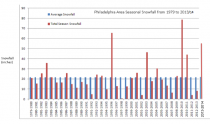
Enlarged
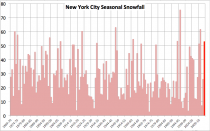
Enlarged
But the climate models are failing miserably.
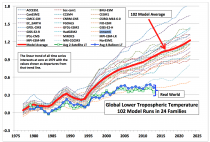
Enlarged
The winter has been much colder than NCDC has shown with raw data.
_thumb.png)
Enlarged
See the long term December/ January trend - you can see the 60 year cycle. This winter is cold but the NCDC numbers are smaller than the raw observation based data used by the models.

Enlarged
The trend is down the last 20 years for the CONUS. THIS IS DECEMBER/JANUARY TREND data downloaded from NOAA NCDC.
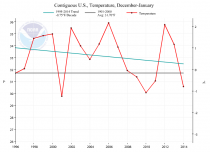
Enlarged
Every one of the 9 climate regions in the US are cooling for 20 years.

Enlarged
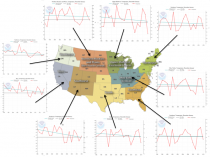
Enlarged
Link to all the regions here.
|










_thumb.png)



